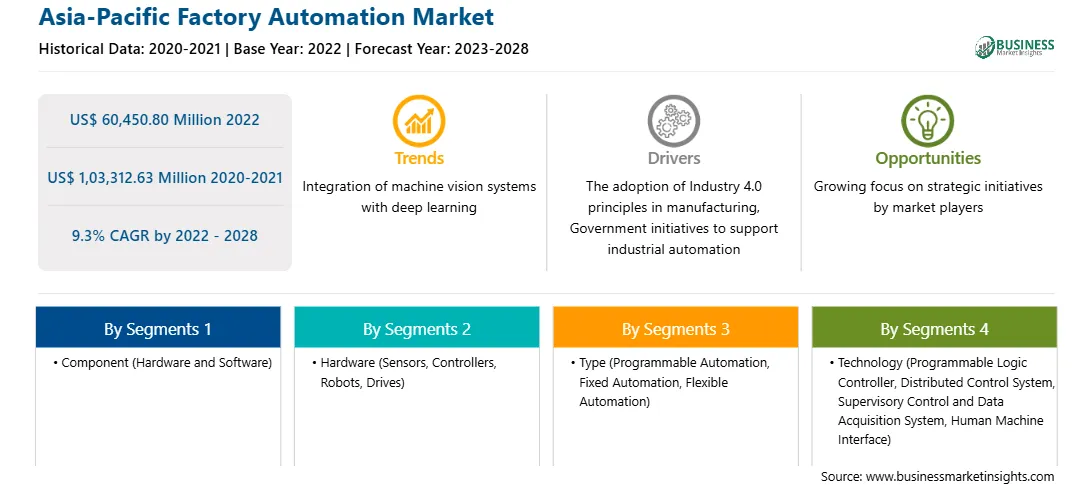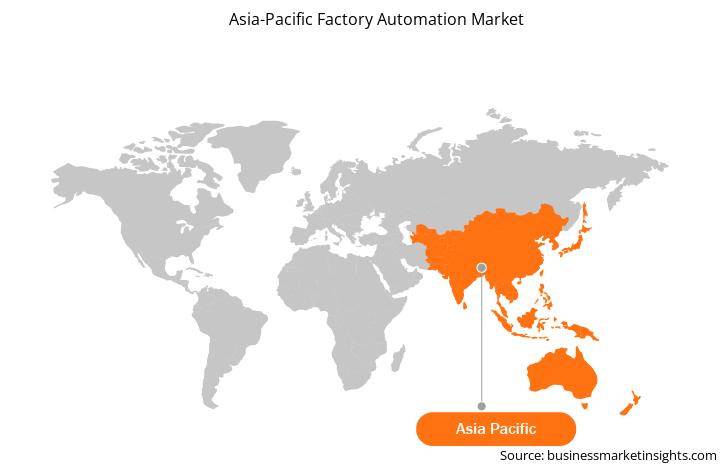The factory automation market in APAC is expected to grow from US$ 60,450.80 million in 2022 to US$ 1,03,312.63 million by 2028. It is estimated to grow at a CAGR of 9.3% from 2022 to 2028.
Rising adoption of factory automation across automotive industry
The growing demand for automobiles is subsequently leading to the need for an automation system as it helps manufacturers increase outputs while decreasing the cost and risk of human workers. In the current scenario, collaborative robots, robotic arms, and the Internet of Things coupled with AI are widely adopted in the automotive industry, making the manufacturing process faster and accurate. According to the report by International Federation of Robotics, in 2019, the robot density in the US automotive industry was 1,287 installed units per 10,000 employees, making the country ranked 7th worldwide. Further, KUKA and Universal Robots produce and supply cobots to automotive companies such as Tesla to build cars. Tesla has developed driverless car hardware called Autopilot, which uses AI technology. Companies such as IBM and BMW are combining cognitive computing and IoT to invent autonomous cars, which can communicate while linking driving patterns with the human driver's emotional response in all possible scenarios. In addition, automakers like Ford Motor Co. and BMW AG are working on deployment of the 3D printer technology. Moreover, various other automakers are also utilizing virtual and augmented reality to address manufacturing issues. Thus, the aforementioned advanced automation technologies ease the automotive manufacturing process at nearly every stage of vehicle production, in turn, catalyzing the market expansion.
Market Overview
The Asia Pacific factory automation market is further segmented into Australia, China, India, Japan, South Korea, and the Rest of Asia Pacific. Japan is one of the world’s number one industrial robot manufacturer. The country delivers almost 45% of the global supply of industrial robots. Due to the rising demand of industrial robots, the manufacturers have considerably increased their production capacity, which has led to the increase in the export of industrial robots in Japan. According to the International Federation of Robotics (IFR), the robot export ratio in Japan rose to 78% and around 136,069 industrial robots were shipped in 2020. Thus, the growing export of industrial robots is propelling the factory automation market. In addition, the government of various Asia-Pacific countries is coming up with various plans and initiatives which may further boost the factory automation market. For instance, in December 2021, China unveiled a sharpened version of the Made in China 2025 industrial policy blueprint. Under this, the government has released a five-year smart manufacturing development plan to digitize 70% of the country’s large enterprises. Thus, the country is focusing on building and owning industrial robots and upgrading equipment and processes used in the manufacturing sector. Such initiatives by the government will further boost the factory automation market in the region.
APAC Factory Automation Market Revenue and Forecast to 2028 (US$ Million)
Strategic insights for the Asia-Pacific Factory Automation provides data-driven analysis of the industry landscape, including current trends, key players, and regional nuances. These insights offer actionable recommendations, enabling readers to differentiate themselves from competitors by identifying untapped segments or developing unique value propositions. Leveraging data analytics, these insights help industry players anticipate the market shifts, whether investors, manufacturers, or other stakeholders. A future-oriented perspective is essential, helping stakeholders anticipate market shifts and position themselves for long-term success in this dynamic region. Ultimately, effective strategic insights empower readers to make informed decisions that drive profitability and achieve their business objectives within the market. The geographic scope of the Asia-Pacific Factory Automation refers to the specific areas in which a business operates and competes. Understanding local distinctions, such as diverse consumer preferences (e.g., demand for specific plug types or battery backup durations), varying economic conditions, and regulatory environments, is crucial for tailoring strategies to specific markets. Businesses can expand their reach by identifying underserved areas or adapting their offerings to meet local demands. A clear market focus allows for more effective resource allocation, targeted marketing campaigns, and better positioning against local competitors, ultimately driving growth in those targeted areas.Asia-Pacific Factory Automation Strategic Insights

Asia-Pacific Factory Automation Report Scope
Report Attribute
Details
Market size in 2022
US$ 60,450.80 Million
Market Size by 2028
US$ 1,03,312.63 Million
Global CAGR (2022 - 2028)
9.3%
Historical Data
2020-2021
Forecast period
2023-2028
Segments Covered
By Component
By Hardware
By Type
By Technology
By Industry Vertical
Regions and Countries Covered
Asia-Pacific
Market leaders and key company profiles
Asia-Pacific Factory Automation Regional Insights

APAC Factory Automation Market Segmentation
The APAC factory automation market is segmented into component, hardware, type, technology, industry vertical and country. Based on component, the market is bifurcated into hardware and software. The hardware segment registered a larger market share in 2022.
Based on hardware, the APAC factory automation market is segmented into sensors, controllers, robots, drives, and other hardware components. The robots segment registered the largest market share in 2022.
Based on type, the APAC factory automation market is segmented into programmable automation, fixed automation, and flexible automation. The fixed automation segment registered the largest market share in 2022.
Based on technology, the APAC factory automation market is segmented into programmable logic controller (PLC), distributed control system (DCS), supervisory control and data acquisition (SCADA), Human-Machine Interface (HMI), and others. The supervisory control and data acquisition system (SCADA) segment registered the largest market share in 2022.
Based on industry vertical, the APAC factory automation market is segmented into automotive, food and beverages, oil and gas, manufacturing, mining, and others. The manufacturing segment registered the largest market share in 2022.
Based on country, the market is segmented into Australia, China, India, Japan, South Korea, and Rest of APAC. China dominated the market share in 2022.
ABB Ltd; Bosch Rexroth AG; Emerson Electric Co.; Fanuc Corporation; General Electric Company; Honeywell International Inc.; Mitsubishi Electric Corporation; OMRON Corporation; Rockwell Automation, Inc.; and Siemens AG are the leading companies operating in the factory automation market in the region.
The Asia-Pacific Factory Automation Market is valued at US$ 60,450.80 Million in 2022, it is projected to reach US$ 1,03,312.63 Million by 2028.
As per our report Asia-Pacific Factory Automation Market, the market size is valued at US$ 60,450.80 Million in 2022, projecting it to reach US$ 1,03,312.63 Million by 2028. This translates to a CAGR of approximately 9.3% during the forecast period.
The Asia-Pacific Factory Automation Market report typically cover these key segments-
The historic period, base year, and forecast period can vary slightly depending on the specific market research report. However, for the Asia-Pacific Factory Automation Market report:
The Asia-Pacific Factory Automation Market is populated by several key players, each contributing to its growth and innovation. Some of the major players include:
The Asia-Pacific Factory Automation Market report is valuable for diverse stakeholders, including:
Essentially, anyone involved in or considering involvement in the Asia-Pacific Factory Automation Market value chain can benefit from the information contained in a comprehensive market report.